
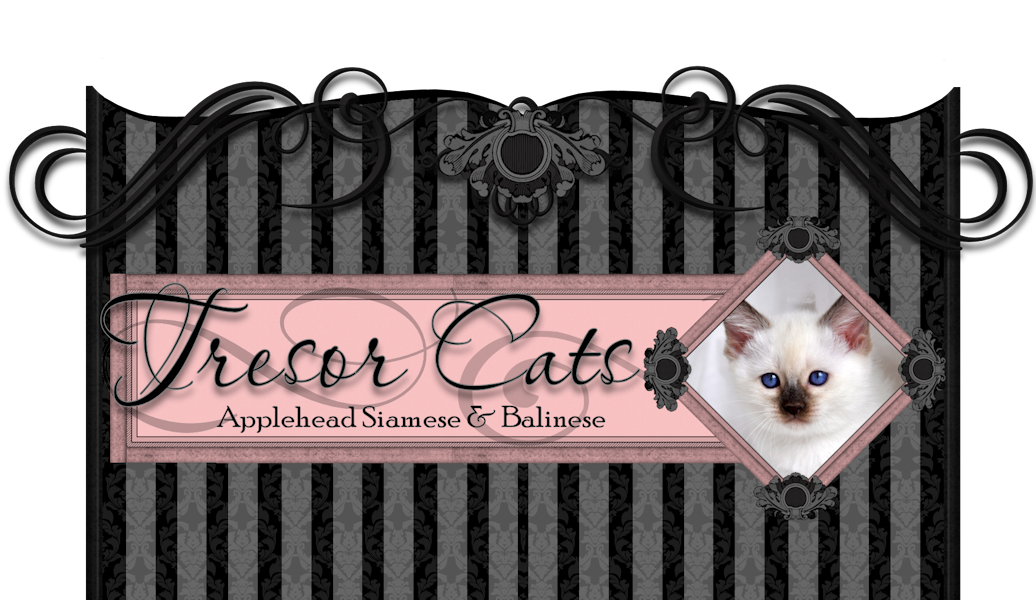

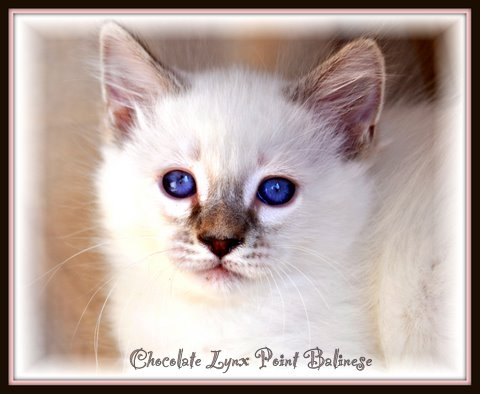



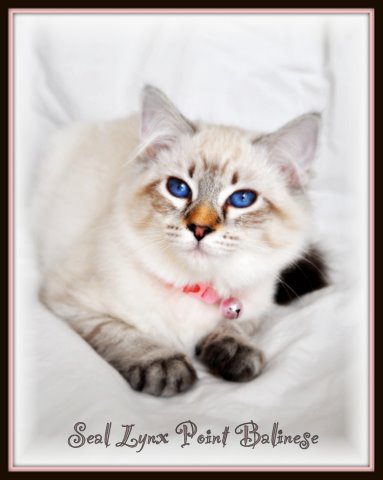

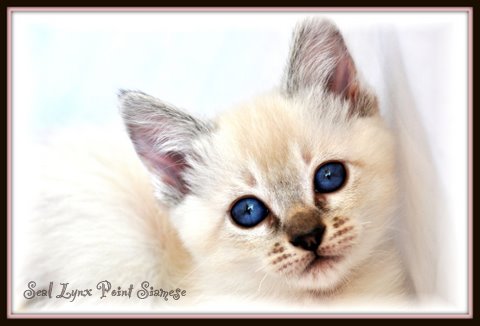
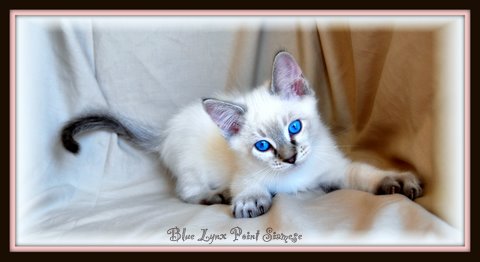
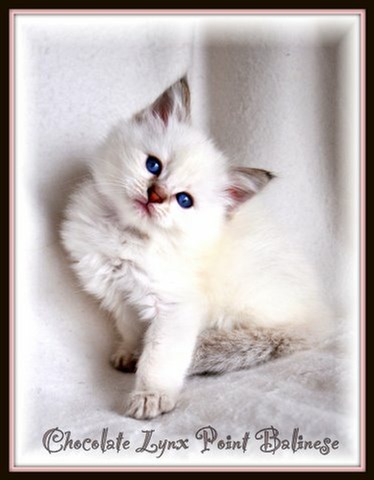



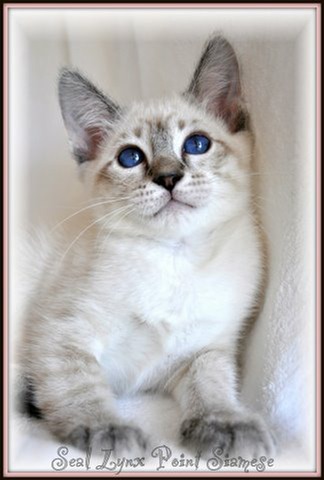

Color Points
There are four popular lynx color points in the Snow Tiger breed.
They are: Seal Lynx Point, Chocolate Lynx Point, Blue Lynx Point, and the Lilac Lynx Point.
I will describe the Lynx color points and show pictures of these lynx color points as examples.
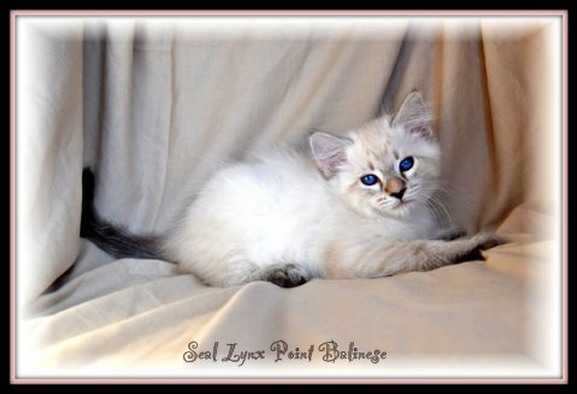
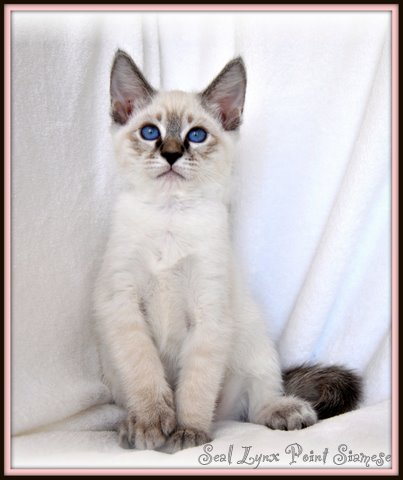
Seal Lynx Pointed Siamese
&
Seal Lynx Pointed Balinese
(Snow tiger Coloring)
Seal Lynx Pointed Siamese & Balinese cats with excellent contrast will always have a light cream or off white body with light chocolate colored banding (striping) on the four legs.
The tail will either be dark colored in solid, or will be ring tailed in dark chocolate almost black.
The face will be masked in light black/brown tabby markings, and the nose fur will be darker.
The ears will be solid dark. As they age, the marking will become darker, but there shall always be a beautiful clear contrast within the tabby markings and the solid off white body tone.
The nose flesh will usually be black completely, but sometimes it can be pink with a dark outline.
In the Balinese snow tiger, you will often times find that the tabby markings are lighter because of their undercoat being lighter.
Note: I have included a picture of a Seal Lynx Point Siamese, and a Seal Lynx Point Balinese to contrast the seal lynx color point differences in the coat/fur.
>^..^<
Chocolate Lynx Pointed Siamese
&
Chocolate Lynx Pointed Balinese
(Snow tiger Coloring)
Chocolate Lynx Pointed Siamese & Balinese cats with excellent contrast will always have a white body with dark beige/caramel colored banding (striping) on the four legs.
The tail will either be a solid dark brown, or will be ring tailed in brown.
The face will be masked in faint light brown tabby markings, and the nose fur will be cinnamon colored more often than not.
The ears will be solid light brown. As they age, the marking will become darker, but there shall always be a beautiful clear contrast within the tabby markings and the solid white body tone.
The nose flesh will usually be pink with a darker outline. And the freckles will be cinnamon colored to compliment the cinnamon nose fur.
In the Balinese snow tiger, you will often times find that the tabby markings are lighter because of their undercoat being lighter.
Note: I have included a picture of a Chocolate Lynx Point Siamese, and a Chocolate Lynx Point Balinese to contrast the Chocolate lynx color point differences in the coat/fur.
Blue Lynx Pointed Siamese
&
Blue Lynx Pointed Balinese
(Snow tiger Coloring)
Blue Lynx Pointed Siamese & Balinese cats with excellent contrast will always have a white body with slate gray colored banding (striping) on the four legs.
The tail will either be a solid dark gray/black, or will be ring tailed in dark gray/black.
The face will be masked in faint gray tabby markings, and the nose fur will be light brown colored more often than not.
The ears will be solid gray. As they age, the marking will become darker, but there shall always be a beautiful clear contrast within the gray tabby markings and the solid white body tone.
The nose flesh will usually be pink with a dark thick outline. And the freckles will be brown colored to compliment the nose fur.
In the Balinese snow tiger, you will often times find that the tabby markings are darker because of their undercoat being grayish/cream.
Note: I have included a picture of a Blue Lynx Point Siamese, and a Blue Lynx Point Balinese to contrast the blue lynx color point differences in the coat/fur.
>^..^<
Introduction To The Siamese Snow Tiger & The Balinese Snow Tiger
(Color Point Lynx) Cat
The term snow tiger was coined for the similarity in look of the Lynx Siamese cats and the White Siberian Tigers. The snow tiger domestic cat exists in both short hair (Siamese), and long hair (Balinese). The snow tiger Siamese is basically a hybrid of an apple head Siamese & an Oriental Short Hair, &/Or a Color Point Short Hair (CPSH). A rise in popularity has started to circulate this Siamese hybrid in recent years, so we are to continue to see more in the future in all four lynx color point varieties (Seal Lynx Point, Chocolate Lynx Point, Blue Lynx Point, Lilac Lynx Point). To understand the breed precisely I need to emphasize the Color Point Short Hair/Long Hair, Oriental Short Hair/Longhair, and Javanese breeds as they play a key role in the matrix of the Snow Tiger Siamese & Snow Tiger Balinese (Lynx) breeds.

Color Point Short Hair Breed History
The story of the Color Point Short Hair began as early as 1902, when “tabby point Siamese” were produced and these are mentioned in a book titled “The book of the cat”, by Frances Simpson. They appeared in Scotland more recently where in 1944-
Color Point Short Hair Breed Description
The term “Color Point Short Hair” was coined to identify Siamese cats in other colors and patterns in Registries which did not wish to include them in the Siamese breed group -
The general body color should be pale and free from hip spots or extraneous patterns and the ears are solid colored (except in Tortie/Torbie patterns) with a characteristic “thumb print” mark. Although the preferred tabby pattern is distinctly striped on the points, some agouti ticked or “Abby Patterned” Color Points have done very well on the show bench. This pattern is especially popular with breeders who want to produce clear reds without the striping. Nose leather (flesh) conforms to the recognized Siamese standard for particular color of points or is pink with a dark outline. The Tabby pattern is dominant, however, two solid points from a tabby point breeding (tabby carrying the recessive solid pattern) will not produce tabby pointed offspring.
Note: Color Point Short Hair description is the same for the Color Point Long Hair Cat, the only difference being the coat length, and texture.
Color Point Short Hair Breed Temperament
Color Point Short Hairs are affectionate, sociable, and have an interactive personality as well as the high intelligence of the original oriental type cats. This breed is best suited to extroverts ho enjoy conversation and interaction with their cats. Affectionate and demonstrative, it likes socializing with it’s “people” as well as with other pets in a household. The Color Point Short Hair integrates well into dog households and fetches and leash trains easily. This is a curious, active, vocal, affectionate and intelligent breed. The Color Point Short Hair breed appreciates a “birds eye view”, and is often found on top of the refrigerator or up on a window sill. These wonderful cats are quite capable of creating shenanigans if they are left to their own devices during an extended period of time without attention or supervision.

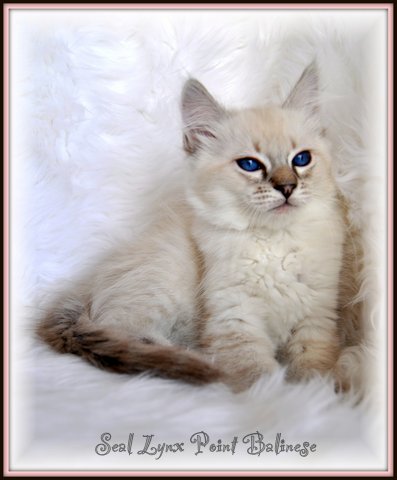
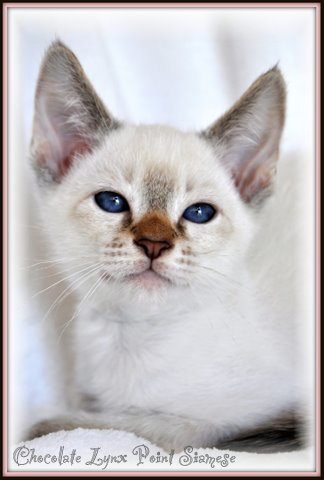

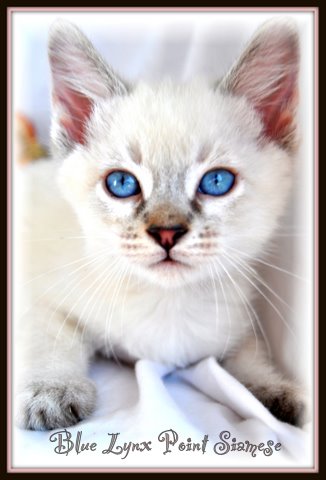
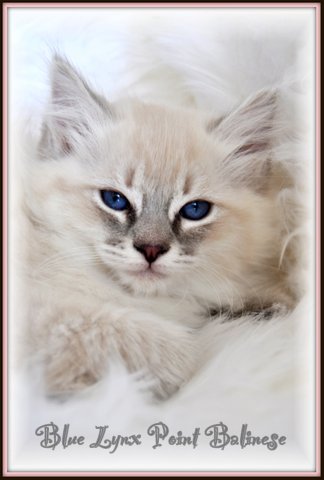
Lilac Lynx Pointed Siamese
&
Lilac Lynx Pointed Balinese
(Snow tiger Coloring)
Lilac Lynx Pointed Siamese & Balinese cats with excellent contrast will always have a white body with lilac colored banding (striping) on the four legs (very faint).
The tail will either be a solid lilac or will be ring tailed in lilac.
The face will be faintly masked in lilac grayish tabby markings, and the nose fur will be light brown colored more often than not.
The ears will be solid lilac. As they age, the marking will become darker on the face and tail, but there shall always be a beautiful white coat to contrast the lilac tabby markings and the solid white body tone.
The nose flesh will usually be pink with a darker outline. And the freckles will be lilac colored to compliment the nose fur.
In the Balinese snow tiger, you will often times find that the tabby markings are lighter because of their undercoat being pure white.
Note: I have included a picture of a Lilac Lynx Point Siamese, and a Lilac Lynx Point Balinese to contrast the lilac lynx color point differences in the coat/fur.
>^..^<


A cat is a lion in a jungle of small bushes.
-
"Of all God's creatures, there is only one that cannot be made slave of the lash. That one is the cat. If man could be crossed with the cat it would improve the man, but it would deteriorate the cat."
-
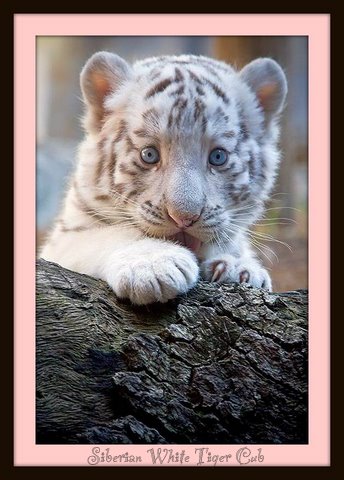
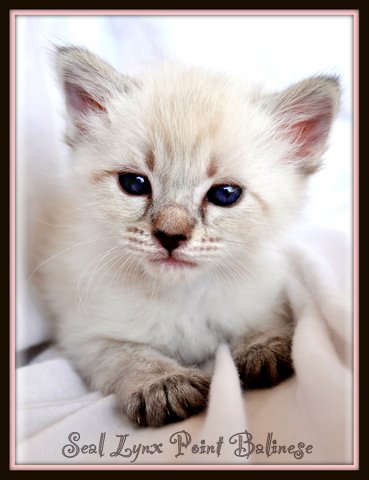

© All images, content, and text are Copyright reserved @TresorSiameseCats.com 2010-
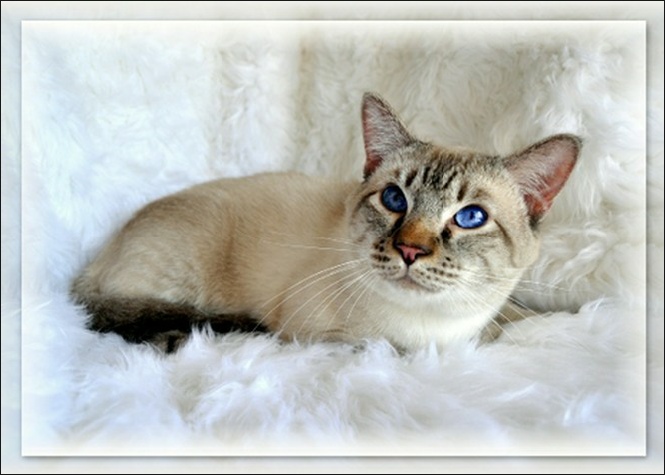

This page is dedicated to the cat that started my lynx point breeding program. Israel My Glory of Tresor Cats, who is a Chocolate Lynx Point Siamese, that carried the long hair recessive gene. This cat is now retired from my breeding program.
Thank you Israel for being a great stud cat, and thank you also for your beauty and great temperament that was passed onto your offspring. >^..^<

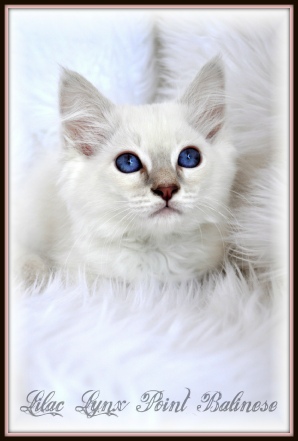

Home | Kitten Litters | Sires | Balinese Queens | Siamese Queens | Kitten Waiting List | Life’s Abundance Cat Food | NuVet Plus Vitamins | Balinese Cat History
Siamese Cat History | Snow Tiger Lynx Point History | Guest book | Sites & Links | References | Past Kittens | Celebrities & Siamese Cats | Cat Trees | FAQ | Kitten Kits
New Kitten Checklist | Feline Health Directory | Early Spaying & Neutering |Agreements | Available Adults | Site Map | Contact Us | Client Kitten Pictures
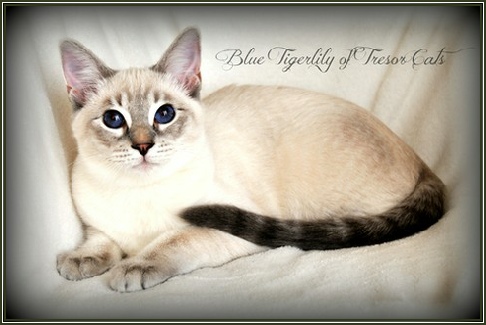
Oriental Shorthair Breed History
An elegant feline breed, Oriental Shorthair traces it’s origin back to Thailand centuries ago. It occurred in Siam, alongside the Siamese for a long time as a self-
Oriental Shorthair Breed Description
The Oriental Shorthair is a member of the Siamese family. They can be found in solid colors (white, red, chocolate, cream, ebony, blue, lavender, cinnamon, or fawn), smoke (white undercoat to any of the above), shaded (only the hair tips), parti-
Oriental Shorthair Breed Temperament
Oriental Shorthairs are intelligent, social animals, who bond very closely to their people
They are inquisitive, friendly, emotional, demanding, and often quite vocal. They like to explore everything and can be overly attached to people. They are often compared to dogs like some other cat breeds, owing to their loyalty and affectionate personality.
They will depend on and trust you forever if you love and take great care of them. Their purr can be extremely loud when happy.
Javanese Breed History
The Javanese is one breed in a line of designer Siamese style cats that includes the Balinese, Colorpoint Shorthair, Oriental Shorthair, and Oriental Longhair. These breeds were inspired by breeders, who wanted to take the qualities of the Siamese and alter the coat and colors to their liking. All of these breeds share similar confirmations and personality types. The differences between these breeds lie in the coat length, colors, patterns, and the cat association to which you happen to subscribe to.
The Siamese comes in four pointed colors: Seal, Blue, Chocolate and Lilac. The Balinese is a long-
The CFA is the only registry that separates the breeds into the classifications, Colorpoint Shorthair and Javanese. The other registries merely extended the color parameters of the Siamese, and the Balinese to include the wider range of colors.
The CFA‘s reasoning behind the separate designations is that Colorpoint Shorthair‘s, and Javanese are hybrids, which they are, since these colors were created by crossing the Siamese, with other purebred cat breeds. However, some breeders feel that separating the Balinese and the Javanese is like splitting cat hairs; both breeds share a body type, personality, and coat. And besides, the hybridization happened so long ago, that it no longer matters. Other breeders zealously want the breeds kept separate to maintain the purity of the Siamese and the Balinese lines.
The Javanese shares much of its history with the Balinese breed. The Javanese isn’t from the isle of Java anymore than the Balinese is from Bali; the name was bestowed, because of the nice, romantic ring to it. One of the foundation cats of the Javanese breed was created by crossing a Balinese to a Colorpoint Sorthair. The result was a cat with all the characteristics of a Siamese, but with a longer coat length, and a color outside of the basic four. These colorful longhairs were recognized by the CFA in 1987.
Copyright © 1998 by Barron’s Educational Series, Inc., based on ENCYCLOPEDIA OF CAT BREEDS by J. Anne Helgren.
Javanese Breed Description
The Javanese coat is one of their most distinctive features, a soft, silky single coat that lies close to the body and develops into a plume on the tail. The fur should be two to three inches long on the body, longer and fuller on the tail to create the plume. Because there is no undercoat, they require little grooming and usually keep themselves immaculate. Normally, baths are only necessary for showing and then a single lather, rinse, and quick blow dry produce a show finish. The fuller coat softens the lines of the cat, and they might not appear as extreme as their short haired parent breeds.
Javanese cats come in a variety of colors. However, not all colors are accepted by all associations. Blue, black, chocolate, red, cream, tortie, lynx, tabby, and torbie points are noted in Javanese cats. The most popular color patterns for the Javanese are in Lynx and Tortie.
Specialty breeders concentrate on the Seal Lynx, Chocolate Lynx, Blue Lynx and Lilac Lynx patterns.
Javanese Breed Temperament
The parent breeds are the Siamese, Colorpoint Shorthair and Balinese. The Javanese’s personality is similar to the parent breeds, active, playful and extremely affectionate and intelligent. It is an extremely intelligent breed, and will soon assert it’s rightful place in your household as “major domo”, telling you in its sweet voice that it is time for dinner or for a play session.
They definitely want to be with their humans, on the lap, shoulder and if allowed, in bed. Javanese do talk, but usually only when they want to communicate something; and they have a variety of voices and vocal tones depending upon what they want to express to you. They are intelligent and have been known to play fetch, find treats in pockets and be trained to do tricks. They adapt to their owners routines, that is, if they don’t train their humans first.
Javanese are insatiably curious and quite fearless. There is little they will not invesitate or challenge in play. The Javanese are excellent with children as they are known to play for hours on end.
In Conclusion
The Snowtiger is quickly gaining steam in popularity to its compatriots thanks to the feline contributors who are devoted to its existence. They encompass all of the desirable traits of the Siamese, Balinese, CPSH/CPLH, Oriental SH/LH, and Javanese. The hope & goal is that one day they will be accepted in breed and exact type by all show registries in North America. Although a hybrid in its beginnings, it is already in a class of its own for beauty, health, and temperament. Snowtigers should only be tabby marked, carry larger rounded/almond shaped blue eyes, and have a little bit of a wild cat look about them. Think of them as a small and domesticated Siberian tiger, that is docile and childlike in every way.
They are not as common in North America (or the world), and are considered to be a bit exclusive since not many breeders can create them today. Reserve yours today, and get ready for joy, thrilling moments and the love and companionship of a gorgeous feline friend.

| Sires |
| Queens |
| Balinese Queens |
| Siamese Queens |
| Lifes Abundance Cat Food |
| NuVet Plus Vitamins |
| Balinese Cat History |
| Siamese Cat History |
| Snow Tiger (Lynx) History |
| Allergy Test Kits |
| doTERRA Essential Oils |
| Guestbook |
| Sites & Links |
| References |
| Past Kittens |
| Client Kitten Pictures |
| Celebrities & Siamese |
| Cat Trees |
| Retired Cats (Ancestors) |
| FAQ |
| Breed Color Points |
| Torties and Red Points |
| Kitten Kits |
| New Kitten Checklist |
| Feline Health Directory |
| Early Spaying & Neutering |
| Agreements |